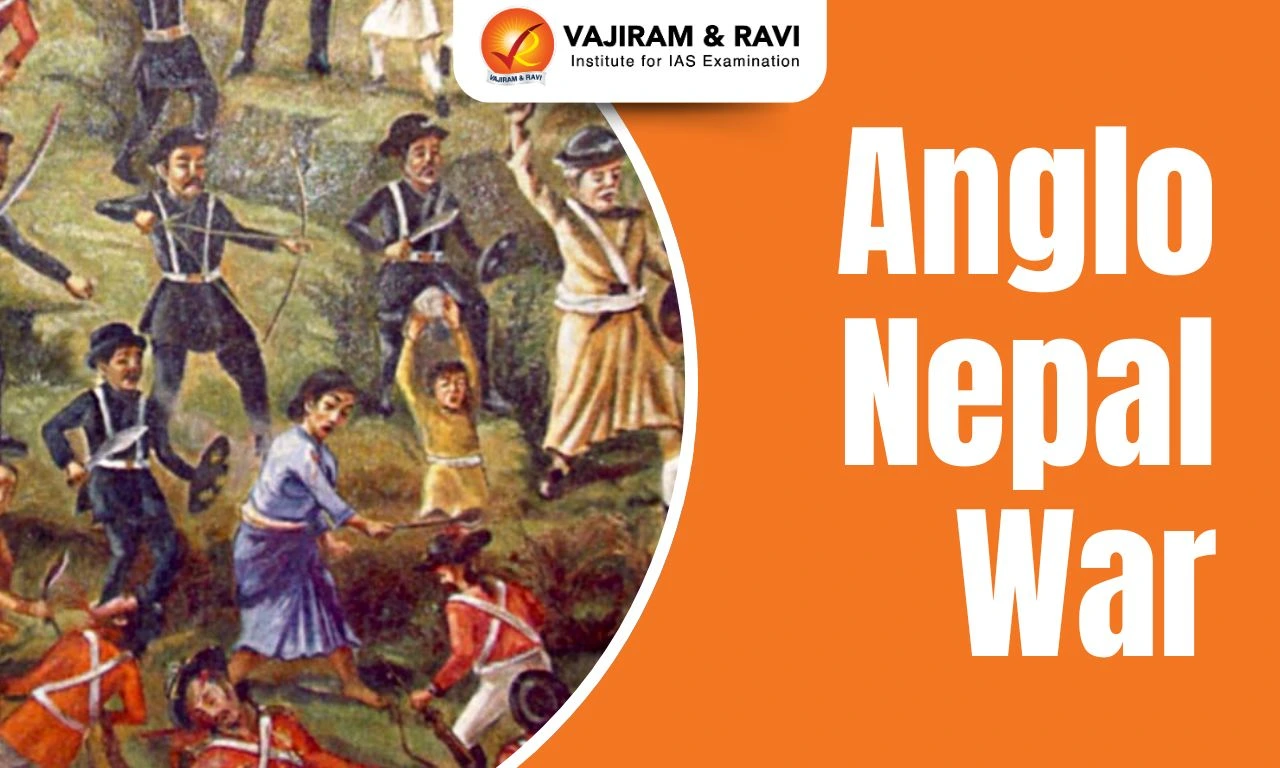The Anglo-Nepal War (1814-1816), also known as the Gorkha War was a significant military conflict between the British East India Company and the Kingdom of Nepal. This war marked the first major military engagement between the British and the Gurkhas, showcasing the rising power of British colonial ambitions in India and the formidable resistance posed by Nepalese forces.
The war concluded with a decisive victory for the British, leading to the signing of the Treaty of Sugauli in 1816, which resulted in the cession of various territories previously under Nepalese control to the EIC.
Anglo-Nepal War Background
The Kingdom of Nepal, established in the 18th century under King Prithvi Narayan Shah, expanded rapidly through conquests. By the early 19th century, it had emerged as a formidable regional power. The British East India Company, seeking to consolidate its influence in India, viewed Nepal’s expansion as a threat to their interests in the region. Initial tensions arose from border disputes and competing ambitions.
Anglo-Nepal War Causes
In the years leading up to the Anglo-Nepal War, both the British East India Company and the Kingdom of Nepal were engaged in territorial expansions. The British consolidated their influence in India from key bases such as Calcutta, Madras, and Bombay. Meanwhile, Nepal was extending its reach into Sikkim to the east, the Kumaon and the Garhwal to the west, and Awadh to the south.
- Territorial Conflict: The clash over borderlands, coupled with British efforts to demarcate territories through surveys, heightened tensions. The immediate cause of the 1814 Anglo-Nepalese conflict was the Nepalese occupation of the Terai region of Butwal, which was under British protection.
- Economic Interests: The British aimed to secure trans-Himalayan trade routes for access to valuable markets in Tibet and China, which were threatened by Nepal’s territorial conquests. Efforts to negotiate trade agreements were repeatedly rebuffed by the Nepalese, leading to increased frustration among British officials.
- Security Concerns: Nepal’s proximity to British-held Bengal further motivated the conflict. The Company feared potential anti-British alliances forming in northern India, compounded by the Gorkhas’ previous military successes.
These intertwined territorial, economic, and security issues ultimately contributed to the outbreak of the war.
Anglo-Nepal War Course
The Gurkha army, under the command of Amar Singh Thapa, numbered between 5,000 and 8,000 men. Despite their smaller size, they had the advantage of fighting on familiar terrain, giving them a strategic edge. The rugged terrain hampered the EIC’s logistics, including difficulties in transporting artillery and supplying troops. The Gurkhas’ forts, often on hilltops, were highly defensible, causing problems for EIC assaults.
- One major EIC loss occurred at the Battle of Jitgadh, where General Wood’s forces were defeated by Gurkha commander Ujir Singh Thapa.
- Major General Gillespie, leading another EIC force, was an early casualty while attempting to take the fort of Jaitak near Dehra in late 1814.
- The decisive EIC victory came on 28 February 1816 at the Battle of Makwanpur, led by Ochterlony, after his strategic efforts to position heavy cannons by building roads.
- Despite the Gurkhas’ defensive efforts and threats to EIC supply lines, the relentless British campaigning and superior resources led Nepal to sue for peace.
Treaty of Sugauli
The Anglo-Nepalese War concluded with the signing of the Treaty of Sugauli in 1816, heavily favouring the British East India Company. The treaty resulted in significant territorial losses for Nepal and a shift in its political relations with the British.
- Nepal agreed to accept a British resident within its territory.
- Nepal ceded the districts of Garhwal and Kumaon and relinquished claims over the Terai region.
- Nepal also withdrew from its territorial claims in Sikkim.
Anglo-Nepal War Aftermath
Following the 1816 Treaty of Sugauli, Nepal was forced to relinquish several territories, including Kumaon and Garhwal. Despite these losses, Nepal did not have to pay an annual subsidy to the British East India Company, a privilege not extended to many Indian princely states. This treaty, unlike many others of the time, remained effective for long. As a result, there were no further conflicts between Nepal and the EIC.
Last updated on June, 2025
→ UPSC Notification 2025 was released on 22nd January 2025.
→ UPSC Prelims Result 2025 will be out soon for the CSE held on 25 May 2025.
→ UPSC Prelims Question Paper 2025 and Unofficial Prelims Answer Key 2025 are available now.
→ UPSC Calendar 2026 is released on 15th May, 2025.
→ The UPSC Vacancy 2025 were released 1129, out of which 979 were for UPSC CSE and remaining 150 are for UPSC IFoS.
→ UPSC Mains 2025 will be conducted on 22nd August 2025.
→ UPSC Prelims 2026 will be conducted on 24th May, 2026 & UPSC Mains 2026 will be conducted on 21st August 2026.
→ The UPSC Selection Process is of 3 stages-Prelims, Mains and Interview.
→ UPSC Result 2024 is released with latest UPSC Marksheet 2024. Check Now!
→ UPSC Toppers List 2024 is released now. Shakti Dubey is UPSC AIR 1 2024 Topper.
→ Also check Best IAS Coaching in Delhi
Anglo-Nepal War FAQs
Q1. Who won the Anglo-Nepalese War?+
Q2. Who was the Governor-General during the Anglo-Nepal War?+
Q3. Which was the first Anglo-Nepal War Treaty?+
Q4. Who was the first king of Nepal?+
Q5. What are the main causes of the Anglo-Nepal War?+
Tags: anglo-nepal war quest




















